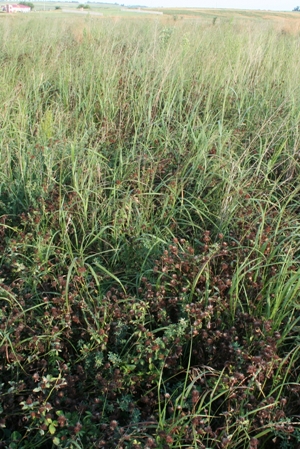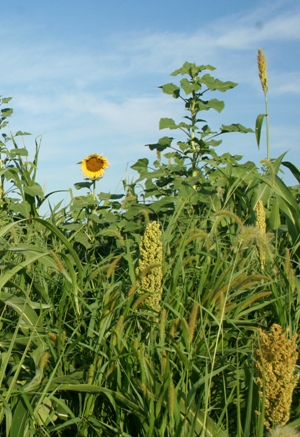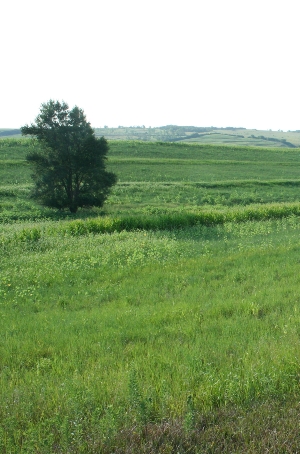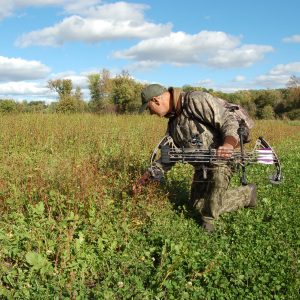Raising upland birds. For those hunters who have been fortunate enough to experience a quality upland bird hunt, they know how addictive the sport can be. The thrill of watching a well-trained pointer flushing a pheasant or covey of quail out of cover is a rush that keeps scores of sportsmen coming back for more.
“As addicting as those moments may be for those who choose this sport, habitat management is the key to making it happen,” says Trent Leichleiter, of “Pheasant Bonanza” in Tekamah, Nebraska. Pheasant Bonanza typically hunts between 3,000 and 5,000 hunters per year on properties they manage, so they have to make sure that birds that are either naturally occurring or are released “stay on their properties.”
“The keys to keeping and raising upland birds on a property is food, water, and a shelter source,” says Leichleiter, who has managed Pheasant Bonanza intensively for the past five years. “I see a lot of clubs that have brome patches and they wonder why their birds won’t stay around. You must have a mix of thick and thin grasses to provide cover for the birds and protect them from raptor predators such as hawks.”
 “Native warm season grasses like Indian grass, big bluestem and little bluestem work very well for providing cover. We plant some cool season varieties as well. Many varieties of non-noxious weeds also provide great cover because they give the birds’ overhead protection, but still allow them a place to run so they can escape danger. It really depends on location as to which grasses or weeds work best. You should talk to your local Pheasants Forever or Quail Forever representative to determine which varieties may work best in your area,” advises Leichleiter.
“Native warm season grasses like Indian grass, big bluestem and little bluestem work very well for providing cover. We plant some cool season varieties as well. Many varieties of non-noxious weeds also provide great cover because they give the birds’ overhead protection, but still allow them a place to run so they can escape danger. It really depends on location as to which grasses or weeds work best. You should talk to your local Pheasants Forever or Quail Forever representative to determine which varieties may work best in your area,” advises Leichleiter.
“We strongly recommend doing a controlled burn every three to five years. It encourages fresh growth and controls the noxious weeds and trees. We find it much easier to spray and remove trees after a burn. One word of caution is that if your birds do not have optional places to go during and after the burn, you may want to burn in blocks to keep your birds from leaving your property completely.”
Leichleiter says they mow strips in their cover and food plots to make hunting easier for their clients. However, Leichleiter says mowed strips do have one drawback. “The disadvantage to mowing strips in your cover is the birds become susceptible to hawks when they are running across the paths. We suspect that 95% of the birds killed by hawks are caught in the mowed strips. Don’t get me wrong, mowed strips serve a purpose, as they slow down wildfires and during the hunt they help to produce birds at the end of field that may have slipped by. But be careful about being too liberal with your strips.”
 As with any animal, having a sustainable food source is crucial. “We have brutal winters, which make having viable food sources all the more important. We plant a variety of food plots, but our favorite product has become Biologic’s Whistleback because it seems to have the mix of millets, sorghum and Egyptian wheat we are looking for. We also use a lot of corn for our food plots. The secret to food plots is making sure you do not have too much or too little. We typically designate about 5% of our land for food plots that we leave standing throughout the season. Our adjoining landowners are grain farmers, so we get a lot of birds from them after they pick their crops. Remember, you need a lot more cover than food plots, although some food plots give you great cover as well.”
As with any animal, having a sustainable food source is crucial. “We have brutal winters, which make having viable food sources all the more important. We plant a variety of food plots, but our favorite product has become Biologic’s Whistleback because it seems to have the mix of millets, sorghum and Egyptian wheat we are looking for. We also use a lot of corn for our food plots. The secret to food plots is making sure you do not have too much or too little. We typically designate about 5% of our land for food plots that we leave standing throughout the season. Our adjoining landowners are grain farmers, so we get a lot of birds from them after they pick their crops. Remember, you need a lot more cover than food plots, although some food plots give you great cover as well.”
Because of the number of hunters that Pheasant Bonanza hosts annually, hunting pressure is undoubtedly an issue. Leichleiter says they release between 15,000 and 20,000 birds each year, with weekly releases based on the number of birds that were harvested the week prior. “We have a number of wild birds in the area too, but released birds are the only way to sustain great hunting throughout the season for us. If we are going to have a lot of hunting pressure during the upcoming week, we release an abundance of birds. During the season we rotate fields daily, and even though we put a lot of pressure on the field, it is amazing how the birds return immediately. Hunters always seem to miss some birds. We are fortunate in that we can alternate fields and keep them stocked day after day. It is not by accident; our management allows us to hold the birds even with the pressure we put on them.”
As with any bird, predator control is an integral part of the management equation, and Leichleiter says Pheasant Bonanza has an intensive program to combat predators. “Obviously, hawks are a big problem, but they are protected by law, so we try to make sure the habitat is such that they cannot pick off our birds with ease. As far as “nest predators,” we have a good trapping program that targets raccoons, skunks, badgers, and opossums, and we try to hunt for coyotes as much as possible. You have to at least try to get ahead of the predators, because they never let up. Unfortunately the fur market has been down the past 20 plus years; so many people do not hunt or trap predators any more. When and if the fur market goes back up there will be a lot less fur bearing predators to deal with.”
 One misconception many people have, according to Leichleiter, is thinking that managing for upland birds cannot coexist with managing for whitetails or wild turkeys. “When you think about it, both deer and turkeys need the same things-food, water and cover-and many times the varieties of both that are either planted, or naturally occurring, may be beneficial to deer, turkeys, and upland birds. Whitetails need warm season grasses and cover plants for bedding areas, and turkeys need those same areas for nesting. Deer and turkey both thrive off of Biologic’s Whistleback as well as planted corn. We frequently see deer and turkeys using the areas we manage for our upland birds. They certainly go hand in hand.”
One misconception many people have, according to Leichleiter, is thinking that managing for upland birds cannot coexist with managing for whitetails or wild turkeys. “When you think about it, both deer and turkeys need the same things-food, water and cover-and many times the varieties of both that are either planted, or naturally occurring, may be beneficial to deer, turkeys, and upland birds. Whitetails need warm season grasses and cover plants for bedding areas, and turkeys need those same areas for nesting. Deer and turkey both thrive off of Biologic’s Whistleback as well as planted corn. We frequently see deer and turkeys using the areas we manage for our upland birds. They certainly go hand in hand.”
Leichleiter says people wishing to manage their property for upland birds need to remember that it will take time and effort to hold birds. “Having a sustainable population on your property is something that will not happen overnight, even with released birds. It has taken us five years to get our fields at Pheasant Bonanza to hold birds from year to year. You will need to experiment to find out which crops and cover mixes work for your property, but remember that the birds need cover first and foremost. It will take time to build it up, but the hard work is certainly worth it when you flush that first pheasant or covey of quail.”
For more information on upland bird hunts and more at Pheasant Bonanza, contact Trent Leichleiter at 1-888-366-4868 or trent@pheasantbonanza.com. They can be reached on the web at www.pheasantbonanza.com!






